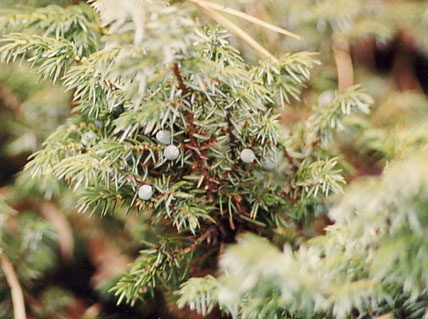English
juniper, commonArapaho
1. ceeh’ee, be’3eino’o ; 2. be’see3 ; 3. to’see3Translation of the Arapaho
1. ‘red inside’ ; 2. ‘red pine’ ; 3. ‘sho rt pine’
Juniper and the Arapaho
Drug: disinfectant. Cedar incense is used as a general disinfectant. It was and still sometimes is used to scare away ghosts. Both Nickerson and Hilger confirm its use as a disinfectant. Kroeber reports that the leaves of cedar were burned for purification after burials.
Drug: gastrointestinal aid. Nickerson reports that a tea was made from J. communis “for bowel trouble.”
Drug: pediatric aid. Hilger reports that “children were given a decoction of cedar bark to drink and finely chopped cedar bark to chew.”
Drug: respiratory aid, cough medecine, throat aid, cold remedy, herbal steam. Fortreatment of colds, respiratory congestion, coughs, sore throats. People today boil the needles and/or, then place a blanket or towel over the mixture and inhale the steam beneath the blanket to relieve congestion from colds. A tea is made by boiling the berries. This is drunk to treat coughs. This can also be gargled for sore throats.
Other: ceremonial incense. This plant is widely used for “smuding” or “cedaring” - ritual purification through incense. In the field, both of the above named species have been identified with the Arapaho name. Nickerson confirms the use of J. communis. He says the needles were “burned as a disinfectant,” and “ground for their scent.”
Toll 1914 identifies his name with “juniper bush” and says that the Arapahos “made cups of them.” This may be a misunderstanding/mistranslation of the name: 3eiyoo can mean ‘cup’ in Arapaho. Hayden’s <to-sath>, given for “Juniperus,” is recognized by some people today, who identify it with this species. Hayden identifies<sath-i-win> = “little pine berries” with “a species of trailing Juniperus.”

Juniperus communis